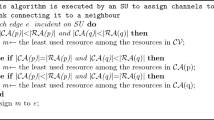Abstract
Spectrum sensing is considered as the cornerstone of cognitive radio networks (CRNs). However, sensing the wide-band spectrum results in delays and resource wasting. Spectrum prediction, also known as channel status prediction, has been proposed as a promising approach to overcome these shortcomings. Prediction of the channel occupancy, when feasible, provides adequate means for an SU to determine, with a high probability, when to evacuate a channel it currently occupies in anticipation of the PU’s return. Spectrum prediction has great potential to reduce interference with PU activities and significantly enhance spectral efficiency. In this paper, we propose a novel, coalitional game theory based approach to investigate cooperative spectrum prediction in multi-PU multi-SU CRNs. In this approach, cooperative groups, also referred to as coalitions, are formed through a proposed coalition formation algorithm. The novelty of this work, in comparison to existing cooperative sensing approaches, stems from its focus on the more challenging case of multi-PU CRNs and the use of an efficient coalition formation algorithm, centered on the concept of core, to ensure stability. Theoretical analysis is conducted on the upper bound of the coalition size and the stability of the formed coalition structure. A through simulation study is performed to assess the effectiveness of the proposed approach. The simulation results indicate that cooperative spectrum prediction leads to more accurate prediction decisions, in comparison with local spectrum prediction individually performed by SUs. To the best of our knowledge, this work is the first to use coalitional game theory to study cooperative spectrum prediction in CRNs, involving multiple PUs.





Similar content being viewed by others
References
Huang W, Wang X (2012) Capacity scaling of general cognitive networks. IEEE/ACM Trans Netw 20(5):1501–1513
Wang X, Huang W, Wang S, Zhang J, Hu C (2011) Delay and capacity tradeoff analysis for motioncast. IEEE/ACM Trans Netw 19(5):1354–1367
Li W, Cheng X, Jing T, Cui Y, Xing K, Wang W (2013) Spectrum assignment and sharing for delay minimization in multihop multi-flow crns. IEEE J Sel Areas Commun (JSAC) 31(11):2483–2493
Haykin S (2005) Cognitive radio: brain-empowered wireless communications. IEEE JSAC 23(2):201–220
Xing X, Jing T, Huo Y , Li H, Cheng X (2013) Channel quality prediction based on bayesian inference in cognitive radio networks. IEEE INFOCOM
Akyildiz IF, Lee WY, Vuran MC, Mohanty S (2006) Next generation/dynamic spectrum access/cognitive radio wireless networks: a survey. Comput Netw J Elsevier 50:2127–2159
Li H, Cheng X, Li K, Xing X, Jing T (2013) Utility-based cooperative spectrum sensing scheduling in cognitive radio networks. IEEE INFOCOM Mini-Conf
Li W, Cheng X, Jing T, Xing X (2013) Cooperative multi-hop relaying via network formation games in cognitive radio networks. IEEE INFOCOM
Song M, Xin C, Zhao Y, Cheng X (2012) Dynamic spectrum access: from cognitive radio to network radio. IEEE Wirel Commun 19(1):23–29
Xing X, Jing T, Cheng W, Huo Y, Cheng X (2013) Spectrum prediction in cognitive radio networks. IEEE Wirel Commun 20(2):90–96
Chen Z, Guo N, Hu Z, Qiu R (2011) Experimental validation of channel state prediction considering delays in practical cognitive radio. IEEE TVT 60(4):1314–1325
Chen Z, Hu Z, Qiu R (2009) Quickest spectrum detection using hidden markov model for cognitive radio. IEEE MILCOM:1–7
Akbar I, Tranter W (2007) Dynamic spectrum allocation in cognitive radio using hidden markov models: poisson distributed case. IEEE SoutheastCon:196–201
Li Z, Yu F, Huang M (2009) A cooperative spectrum sensing consensus scheme in cognitive radios. IEEE INFOCOM:2546–2550
Yang Y, Liu Y, Zhang Q, Ni L (2010) Cooperative boundary detection for spectrum sensing using dedicated wireless sensor networks IEEE INFOCOM:1–9
Shehory O, Kraus S (1998) Methods for task allocation via agent coalition formation. Artif Intell 101 (1–2):165–200
Saad W, Han Z, Debbah M, Hjorungnes A, Basar T (2009) Coalitional games for distributed collaborative spectrum sensing in cognitive radio networks. IEEE INFOCOM:2114–2122
Fcc 10-174: Second memorandum opinion and order (2010)
Kim H, Shin K (2010) Asymmetry-aware real-time distributed joint resource allocation in ieee 802.22 wrans. IEEE INFOCOM:1–9
Fehske A, Gaeddert J, Reed J (2005) A new approach to signal classification using spectral correlation and neural networks. IEEE DySPAN:144–150
Digham F, Alouini M-S, Simon M (2003) On the energy detection of unknown signals over fading channels. IEEE ICC 5:3575–3579
Ghosh C, Cordeiro C, Agrawal D, Rao M (2009) Markov chain existence and hidden markov models in spectrum sensing. IEEE PERCOM:1–6
Tumuluru VK, Wang P, Niyato D (2012) Channel status prediction for cognitive radio networks. Wirel Commun Mob Comput:862–874
Welch LR (2003) Hidden Markov models and the Baum-Welch algorithm. IEEE Inf Theory Soc Newsl 53(4)
Bogomolnaia A, Jackson MO, Barbera WTS, Demange G, Greenberg J, Breton ML (2002) The stability of hedonic coalition structures. Games Econ Behav 38(2):201–230
Teguig D, Scheers B, Le Nir V (2012) Data fusion schemes for cooperative spectrum sensing in cognitive radio networks. Commun Inf Syst Conf:1–7
Yi S, Zeng K, Xu J (2012) Secondary user monitoring in unslotted cognitive radio networks with unknown models. Wirel Algoritm Syst Appl 7405:648–659
Proakis J (2001) Digital communications. McGraw-Hill, New York
Banerjee S, Konishi H, Sonmez T (1998) Core in a simple coalition formation game. Soc Choice Welf 18:135–153
Farrell J, Scotchmer S (1988) Partnerships. Q J Econ 103(2):279–297
Acknowledgments
The authors would like to thank the support from the National Natural Science Foundation of China (Grant No. 61371069, 61272505, and 61172074), and the National Science Foundation of the US (CNS-1162057 and CNS-1265311).
Author information
Authors and Affiliations
Corresponding author
Rights and permissions
About this article
Cite this article
Xing, X., Jing, T., Cheng, W. et al. Cooperative Spectrum Prediction in Multi-PU Multi-SU Cognitive Radio Networks. Mobile Netw Appl 19, 502–511 (2014). https://doi.org/10.1007/s11036-014-0507-x
Published:
Issue Date:
DOI: https://doi.org/10.1007/s11036-014-0507-x




